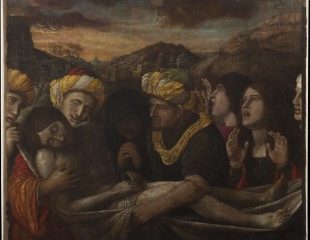
Museums at Work
The Mantegna of Pompeii
A rediscovered masterpiece
Room XVII, Pinacoteca
From 20 March, as part of the Museums at Work programme, the Vatican Museums – as is customary in this particular liturgical time – are inviting pilgrims and tourists to follow the Lenten path through the “rediscovery” of a masterpiece of Art and Faith.
On the special occasion of the Jubilee, the guest of honour of the evocative Room XVII of the Vatican Pinacoteca is a “rediscovered” painting, universally considered missing and only recently attributed to the hand of the great Andrea Mantegna (1431-1506), supreme exponent of the Renaissance.
It is the painting of the Deposition of Christ, now conserved in the Shrine of the Blessed Virgin Mary of the Rosary of Pompeii, which corresponds iconographically to the canvas executed by Mantegna for the Basilica of San Domenico Maggiore in Naples.
In May 2022, at the invitation and intuition of Archbishop Tommaso Caputo, Prelate of Pompeii and pontifical delegate of the Shrine, the fragile painting – still of uncertain attribution and in very compromised conditions of conservation – was transferred, with the authorization of the Archaeological Park, from Pompeii to Rome in order to be entrusted to the care of the laboratories of the Vatican Museums, and then subjected to a complex restoration process, preceded by historical research and advanced non-invasive imaging surveys.
“The painting of Andrea Mantegna of San Domenico Maggiore in Naples is now the Mantegna of Pompeii”, declares the Director of the Vatican Museums, Barbara Jatta, curator of the exhibition project together with Fabrizio Biferali. “We do not have documents attesting to the transfer of the Deposition from the Dominican church in Naples, where it is documented by the sources, to the Shrine of the Blessed Virgin Mary of the Rosary of Pompeii, but the research, examinations and extraordinary results of a long and meticulous research project have confirmed that the Deposition of the Shrine of Pompeii is the work of Mantegna”.
Fundamental to the attribution was also the art-historical research conducted by Stefano De Mieri, of the Suor Orsola Benincasa University of Naples, who had the intuition of the originality of the work – whose file had been published by the Shrine on the website for the cataloguing of ecclesiastical cultural assets of the Italian Episcopal Conference – which enabled him to fully reinstate it within the tradition of Mantegna.
The long and delicate restoration was carried out – under the “spiritual” guidance of the late Guido Cornini, the scientific delegate who passed away prematurely on 18 July 2022 – by Lorenza D’Alessandro and Giorgio Capriotti, in close collaboration with the Directorate of Museums and Cultural Heritage, the Department of XV-XVI Century Art, the Painting and Wood Materials Restoration Laboratory and the Cabinet of Scientific Research.
A longstanding relationship links the Pope’s Museums with the Shrine of Pompeii and its numerous artistic and devotional treasures. Already in 2012 the Vatican research laboratory had taken care of the venerated seventeenth-century Our Lady of Pompeii. Today, exactly ten years after Pope Francis’ first pilgrimage to the Marian city (21 March 2015), and immediately following his announcement, from Gemelli Hospital, of the canonization of Bartolo Longo, founder of the Shrine – the opening to the public of the exhibition “The Mantegna of Pompeii. A rediscovered masterpiece”, ideally returns a gesture of love and is cloaked in strong symbolic, spiritual and auspicious meanings.
The exhibition initiative is accompanied by a catalogue published by Edizioni Musei Vaticani, edited by Barbara Jatta and Fabrizio Biferali.

























